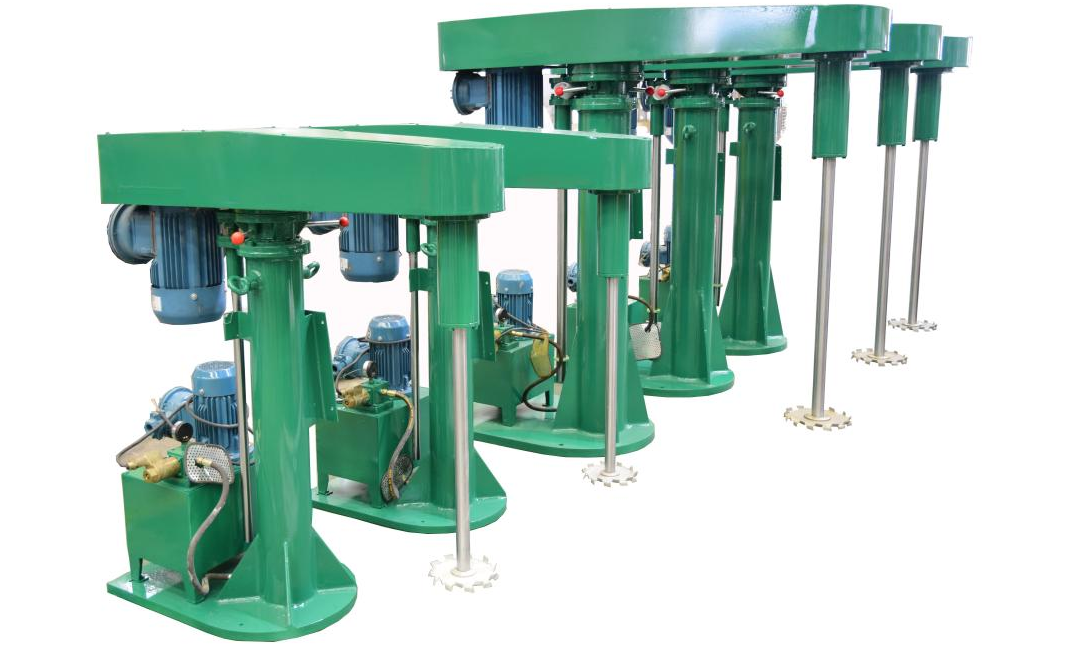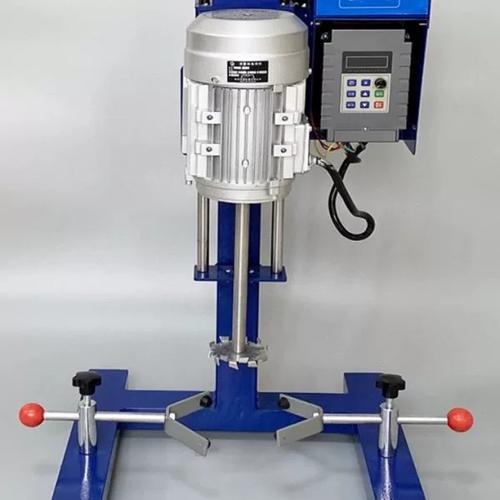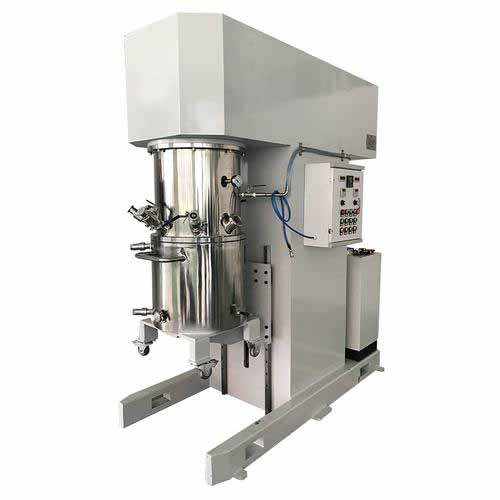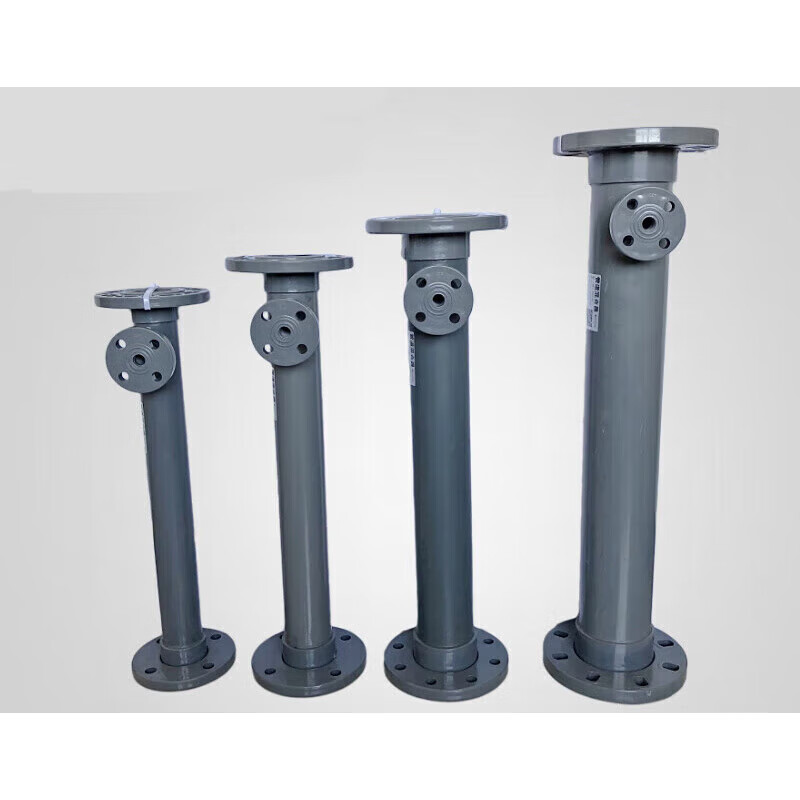In the paint production process, the selection of mixing equipment directly determines product quality, production efficiency, and cost control. Based on mixing principles and application scenarios, paint mixing equipment is primarily categorized into four major types:
High-speed dispersers are core equipment in paint production, generating strong shear forces through high-speed rotation of serrated dispersing discs to achieve uniform dispersion and stable suspension of pigments. Key performance indicators include speed range (typically 0–1,500 rpm), power configuration (commonly 5.5–55 kW), and lifting method (hydraulic or mechanical).
Pneumatic mixers are driven by compressed air, featuring intrinsic safety and explosion-proof characteristics, making them particularly suitable for solvent-based coating workshops. Blade-type pneumatic motors can reach speeds of up to 3000 rpm, while piston-type motors provide higher torque, suitable for high-viscosity materials. Their stepless speed adjustment function is achieved by regulating air pressure, and they feature overload protection—automatically shutting down when the load is jammed without damaging the motor.
Two-component spray systems are designed for reactive coatings such as epoxy and polyurethane, enabling precise, instant mixing of the base material and hardener. The external mixing type uses two main pumps to separately convey the components, which are mixed at the nozzle during atomization, preventing pipeline blockages. This is particularly suitable for fast-drying coatings that cure within 20 minutes.
Powder mixing equipment such as screw belt mixers utilize low-speed, high-capacity mixing to produce three-dimensional motion through the counter-rotating screw belt in a U-shaped trough. Stainless steel ensures corrosion resistance, while the full-opening discharge design facilitates cleaning, making it ideal for powder coating production.
High-Speed Disperser:
The most common and widely used type, particularly suitable for mixing medium- and low-viscosity liquids and pre-dispersing pigments.
Core Component: A high-speed rotating sawtooth disc impeller. The impeller draws the material upward from the bottom and flings it against the container walls at high speed, creating strong turbulence and shear forces.
Advantages: Relatively simple structure, easy operation and maintenance, high efficiency, and a wide range of capacities (from small laboratory beakers to large industrial production kettles).
Disadvantages: Lower efficiency for extremely high-viscosity materials or when extremely fine dispersion (nanoscale) is required; the open design may cause solvent evaporation or introduce air bubbles.
Applications: Pre-mixing and dispersing of latex paints, general industrial paints, inks, adhesives, etc.

Agitators:
Focus on gentle mixing rather than high-shear dispersion. Typically used for low-viscosity, shear-sensitive materials, or for post-dispersion homogenization and color matching.
Core Components: Paddle, anchor, screw, turbine, or other impeller types. Relatively low speed. Advantages: Gentle shear force, less likely to disrupt material structure, less likely to generate bubbles and heat, and suitable for a wide range of viscosities (especially high-viscosity materials).
Disadvantages: Poor pigment dispersion, and may require longer mixing times.
Applications: Mixing low-viscosity varnishes, mixing high-viscosity putties/sealants, blending dispersed paints, and preventing sedimentation during storage.

Grinding Disperser:
Used to achieve extremely fine dispersion and high-quality coatings, inks, etc. Typically used after high-dispersion for fine grinding.
Core Principle: Utilizes the impact, shear, and friction effects of the high-speed motion of the grinding media (beads) within a narrow grinding chamber to break up particle agglomerates.
Advantages: Extremely fine dispersion (down to micrometers or even nanometers) and excellent dispersion quality. Disadvantages: High equipment cost, complex operation and maintenance, relatively low production efficiency (usually used as a fine grinding process), and troublesome cleaning and color change.
Applications: High-demand applications such as automotive paint, high-end industrial paint, metallic paint, pearlescent paint, and electronic ink.

Dual Planetary Mixer:
Designed specifically for ultra-high-viscosity, paste-like materials (such as silicone sealants, epoxy adhesives, paste-like inks, battery slurries, and putty).
Core Components:
Planetary Carrier: Drives two agitators (usually a paddle and a scraper) to rotate around its axis while simultaneously orbiting the central axis of the kettle.
Scraper: Rotates closely against the kettle wall, continuously scraping away material adhering to the wall, ensuring seamless mixing and high heat and mass transfer efficiency.
Advantages: Seamless mixing, particularly suitable for high-viscosity materials, vacuum degassing capability, and excellent sealing.
Disadvantages: High equipment cost and relatively complex structure. Applications: Silicone sealant, epoxy resin adhesive, paste ink, paste cosmetics, lithium battery electrode slurry, high-viscosity putty, etc.

Static Mixer:
Not a “machine” in the traditional sense, but a mixing element installed in a pipeline with no moving parts.
Principle: As the fluid flows through specially designed internal blades or channels, it is continuously divided, reassembled, and twisted, achieving continuous mixing.
Advantages: Simple and compact structure, no moving parts, maintenance-free, low energy consumption, fast and uniform mixing (especially for low-viscosity liquids), and easy in-line installation.
Disadvantages: Not suitable for high-viscosity materials or materials containing large amounts of solid particles, and has limited dispersion capacity.
Applications: Continuous online addition of additives, colorant tinting (such as in automated tinting systems), and in-line mixing of low-viscosity two-component coatings.

Viscosity is the primary factor in equipment selection: Low-viscosity coatings (<100 cps), such as water-based latex paint, can be selected using a conventional mixer; medium-viscosity materials (100-5000 cps), such as oil-based pigmented paint, require medium-power equipment; and high-viscosity resins (>5000 cps) require a high-torque model.
Corrosion assessment influences material selection: 304 stainless steel is suitable for standard solvent-based paints; 316L stainless steel or PTFE-coated anti-corrosion coatings containing chlorine or acidic ingredients require 316L stainless steel.
Solid content and particle size affect dispersion strength: High-solids or large-particle pigments (such as titanium dioxide) require a multi-stage dispersing disc or bead milling system, which uses the synergistic effect of sieve plates and grinding beads to improve dispersion fineness.
Production scale determines equipment capacity: 5-20L portable pneumatic mixers are suitable for laboratories or refinishing applications; fixed hydraulic lift dispersers are required for batch production of 100L or more. Mixing accuracy requirements influence the technical approach: Mechanical stirring is an option for conventional one-component coatings; for two-component coatings with a ratio tolerance >10%, a low-cost mechanical mixing system with a proportioning gun is recommended; for strict ratio requirements (<4% error), an electronic proportioning machine with internal mixing becomes essential.
Special process requirements: Vacuum degassing requires a sealed tank; heat-curing coatings should be equipped with a jacketed heating system; and for fast-acting outdoor applications, external mixing spray equipment is recommended to avoid curing failures.
1. Key Points for High-Speed Dispersers
Speed regulation is key to process adaptability: Variable frequency drive models are preferred. Electromagnetic speed regulation is optional for water-based paints, while oil-based paints must be equipped with explosion-proof variable frequency motors.
Key Component Materials: 304 stainless steel is recommended for the dispersion disc and shaft. The common carbon steel chrome-plated shaft in the industry requires careful evaluation of corrosion resistance.
High-End Process Configurations: A dual dispersion shaft design improves efficiency by 30%; a vacuum system eliminates bubbles; and a multi-stage dispersion disc design optimizes particle size distribution.
2. Scientific Selection of Pneumatic Mixers
Power Matching Principles:
20L low-viscosity paint: 1/3HP vane motor (high speed)
50L medium-viscosity resin: 1/2HP piston motor (high torque)
200L high-viscosity asphalt: 1.5HP heavy-duty motor
Propeller Configuration Options: Three-blade propellers are suitable for homogenizing low viscosities; high-shear dispersion discs address pigment agglomeration; and extended-blade propellers address drum wall residue. Safety Adaptation Solutions: Choose an all-copper pneumatic motor for explosion-proof locations; waterproof models for humid environments; and 316 stainless steel contact parts for food-grade paints.
3. Professional Selection of Two-Component Equipment
Fast-curing paints must use an off-the-gun mixing system (such as the WH46-2). Its mechanical proportioning can be adjusted from 1:1 to 18:1. A dual-piston pump separates and delivers the components, and mixing occurs only at the moment of spraying.
Precision electronic proportioning systems are suitable for ratio-sensitive automotive OEM paints. They use servo motors to control the metering pumps, maintaining an accuracy of ±2%, but require regular calibration.
Airless atomization technology improves coating quality: it reduces paint mist rebound, increases paint utilization by 30%, and, with air assist, achieves a highly decorative finish.
4. Powder Mixing Equipment Selection Strategies
For materials with poor flowability, choose a ribbon mixer with a flying blade assembly to break up lumps and achieve three-dimensional convection.
Fully enclosed stainless steel structures are standard for powder coatings, and a fully open door discharge design ensures no residue. Capacity calculation rule: Taking 400kg of processing capacity per hour as an example, choose a 100kg capacity model and match it with a 15-minute/batch cycle (including loading and unloading).
1. Four-Step Performance Verification Method
Material Authenticity Testing: Use stainless steel identification solutions to verify the authenticity of 304/316 markings to prevent carbon steel impersonation.
Key Test Indicators: Observe shaft radial runout at no load (should be <0.05mm); Test temperature rise under load (temperature rise ≤40°C after one hour of continuous operation).
Mixing Uniformity Verification: Use colorimetry or fluorescent tracers to sample and test component consistency at different locations.
Safety Certification Verification: Explosion-proof equipment must be ATEX or CNEx certified; the IP rating of electrical components must match environmental requirements.
2. Full-Cycle Cost Optimization Model
Avoiding Procurement Cost Traps: A seemingly cheap, standard model in an oil-based workshop may actually require additional explosion-proof retrofitting costs, exceeding the initial price of an explosion-proof model by 30%.
Accurate Energy Consumption Calculation: For pneumatic equipment, calculate the air compressor conversion efficiency; actual energy consumption may be twice that of electric equipment. For high-power dispersers, choosing a permanent magnet motor can save 25% in energy. Maintenance cost prediction: Electronic proportioning system spray guns cost over 10,000 yuan each, while mechanical mixing guns only cost in the thousands. Progressive cavity pumps save 60% on seal replacement costs compared to plunger pumps.
Selecting paint mixing equipment requires a systematic decision-making model: first, identify the paint type, then analyze core parameters, and finally, focus on process characteristics.
Future equipment selection will show two major trends: modular design, such as basic dispersers with reserved vacuum/heating ports to accommodate upgrades; and data connectivity, using IoT sensors to monitor viscosity changes in real time and automatically adjust speed and ratio. Only by combining scientific selection with strategic foresight can we accurately position our core productivity in the competitive industry of improving quality and efficiency.